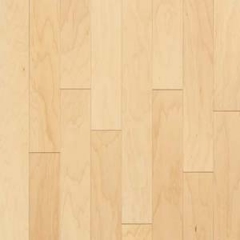Snap Lock Flooring
 First, two planks snap together, and then they lock. With a mechanized system milled in, all boards attach to each other and stay together. A type of floating floor, snap lock flooring does not touch a subfloor directly and, instead, rests on top of underlayment. When all boards are attached together, the floor functions like a unit, expanding and contracting together. Because of this, nearly all snap lock flooring is engineered hardwood. Many hardwood brands, as well, carry snap lock laminate flooring.
First, two planks snap together, and then they lock. With a mechanized system milled in, all boards attach to each other and stay together. A type of floating floor, snap lock flooring does not touch a subfloor directly and, instead, rests on top of underlayment. When all boards are attached together, the floor functions like a unit, expanding and contracting together. Because of this, nearly all snap lock flooring is engineered hardwood. Many hardwood brands, as well, carry snap lock laminate flooring.
Solid hardwoods, although considered the highest quality flooring, expand and contract too much, and over time, the boards may end up buckling or having a tent-like form. Engineered hardwood, on the other hand, consists of three to nine pieces of natural wood bonded together. The grain on each piece faces a different direction, and this feature makes the wood more stable to heat and moisture.
Originally, floating floors attached through glue, but presently, click and lock and lock and fold methods result in less mess. Without glue used, snap lock flooring has a mechanized system, which allows boards to stay in place once the tongue and groove are put together. The boards, however, do not always make a clicking sound. Although snap lock laminate flooring often clicks, engineered hardwoods may need to be tapped together.
Originally, floating floors attached through glue, but presently, click and lock and lock and fold methods result in less mess. Without glue used, snap lock flooring has a mechanized system, which allows boards to stay in place once the tongue and groove are put together. The boards, however, do not always make a clicking sound. Although snap lock laminate flooring often clicks, engineered hardwoods may need to be tapped together.
Installation
Rolling out the underlayment material is the first step of installation. All excess then needs to be cut off. Before you add any planks, find your starting point – the longest parallel wall in the room – and move from left to right. As you lay out the planks, space your boards 18 to 24 inches apart and add scrap wood to the expansion space for alignment.
Some snap lock flooring requires glue, and if this step is specified, put a bead of it on top of the tongue and then align the boards as close as possible. A hammer and tapping block may be needed to get as tight of a fit as possible. Even if glue is not used, a tapping block should be placed next to the aligned plank and be tapped with the hammer until the fit of the tongue and groove is as close as possible. As you keep on doing this, glue may need to be cleaned up, and you should always be checking for gaps between planks.
The last plank, however, may not fit. Instead of forcing it, cut it where the tongues face each other and align the boards.


